Thermal head for a heating radiator: device, operation + installation procedure
A device such as a thermal head for a heating radiator is designed to regulate the heating temperature.With its help, you can use coolant more efficiently and save money.
Guaranteed effect from use - the right choice. To do this, you need to have as much information as possible about these devices.
From this article you will learn about the existing types of thermal heads, their design, operating principle and rules for installing them on radiators. We will also present the main criteria influencing the choice and briefly consider the best manufacturers of such equipment.
The content of the article:
Features of the thermal head structure
The most popular thermal head consists of a body, bellows, locking element, pusher, rod (shut-off cone), return spring, sealing and fastening elements.
The amount of coolant flowing into the radiator is controlled by the valve device. Most products are equipped with this element.
The plastic body is made by hot stamping. It can be either transparent or colored - from white to black. The bellows is made of brass or galvanized steel. In most models, the thermal head housing is for installation on radiators and thermostatic valve compatible.
The bellows filler, such as gas condensate, has the fastest response to temperature fluctuations.
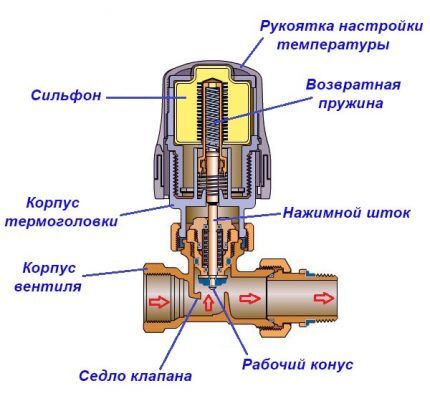
There is a locking element at the very top of the body. It is necessary to fix the settings. If the settings have not been changed for a long period or the moving elements of the device are inactive, they may become stuck.
To combat this phenomenon, experts recommend removing thermal heads from the valves as soon as the heating season ends. When thermostatic valves are designed for a pressure of 4 atm or more, the likelihood of sticking is significantly reduced.
There is such a thing as “gestesis” of the head. The smaller it is, the faster the device responds to temperature changes.
Types of thermal heads and their operating principles
Thermal heads are classified as shut-off and control valves.
There are three types of thermostatic heads:
- manual;
- mechanical;
- electronic.
The functions are the same in all, but the implementation methods are different. Depending on the last parameter, they have different capabilities.
What are manual thermal heads?
In terms of design, thermostatic heads duplicate a standard faucet. By turning the regulator, you can regulate the volume of coolant transported through the pipeline.
Mount them instead ball valves on opposite sides of the radiator.They are reliable and inexpensive, but they will have to be controlled manually, and turning the valve every time, relying solely on your feelings, is not very comfortable. Basically, such thermal heads are installed on cast iron batteries.
If you move the valve stem several times a day, the valve handwheel will become loose. As a result, the thermal head will quickly fail.
Features of mechanical thermal heads
Mechanical type thermal heads have a more complex design and they maintain the set temperature automatically.
The device is based on a bellows in the form of a small flexible cylinder. Inside it is a temperature agent in liquid or gaseous form. As a rule, it has a high coefficient of thermal expansion.
As soon as the set temperature exceeds the norm, under the influence of the internal environment, which has greatly increased in volume, the rod begins to move.
As a result, the cross-section of the thermal head passage channel narrows. In this case, the battery capacity decreases, and, consequently, the coolant temperature decreases to the set parameters.
As the liquid or gas cools in the bellows, the cylinder loses its volume. The rod rises, increasing the dose of coolant passing through the radiator. The latter gradually warms up, the balance of the system is restored and everything starts all over again.
A positive result will only be if there are thermostats in all rooms and on each radiator.
Devices with bellows filled with liquid are more popular. Although gases have a faster reaction, their production technology is quite complex, and the difference in measurement accuracy is only 0.5%.
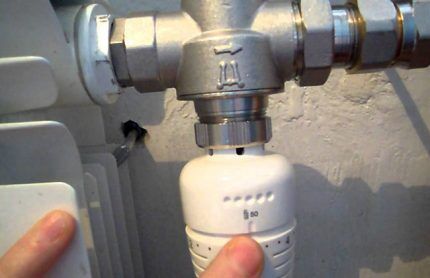
The thermostatic head is mounted so that it is oriented towards the room. This will improve the accuracy of temperature measurement.
If there are no conditions for such an installation, install a thermostat with a remote sensor. It is connected to the thermal head by a capillary tube 2 to 3 m long.
The feasibility of using a remote sensor is due to the following circumstances:
- The heating device is placed in a niche.
- The radiator has a depth of 160 mm.
- The thermal head is hidden behind the blinds.
- The window sill above the radiator is wide, despite the fact that the distance between it and the top of the battery is less than 100 mm.
- The balancing device is located vertically.
All manipulations with the radiator will be performed based on the temperature in the room.
How are electronic thermal heads different?
Since, in addition to electronics, this thermostat contains batteries (2 pcs.), it is larger in size than the previous ones. The rod here moves under the influence of the microprocessor.
These devices have a large set of additional functions. So, they can set the temperature by the clock - at night the room will be cooler, and by the morning the temperature will rise.
It is possible to program temperature readings for individual days of the week. Without reducing the level of comfort, you can significantly save on heating your home.
Although the batteries have enough charge to last for several years, they still need to be maintained. But the main disadvantage is not this, but the high price of electronic thermal heads.
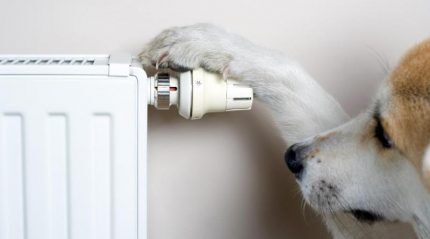
If installed on a radiator decorative screen, the thermal head will be useless. In this case, you will need a regulator with a sensor that records the external temperature.
Rules for installing a thermal head
The connection location when installing a thermal head on a radiator does not depend on its type. In any case, this is a pipe that directly supplies coolant to the battery.
For the device to work correctly, air must continuously circulate around it.
Connection recommendations
Each manufacturer gives recommendations regarding connecting the thermal head.
Despite this, there are general installation conditions:
- The housing must be protected from direct ultraviolet rays. Otherwise, the device will not work accurately.
- The thermal head must be open. It should not be hidden by any protective boxes or furniture.
- The device must not be located above heating pipes. In this case, there will be a discrepancy between the room temperature and the area around the head.
- If the device is practically isolated, you need to arrange bypass line or install a bypass valve in the area of the supply and return pipes.
- The connected piping must not exert pressure on the valve body.
During installation, the thermal head regulator must be set to maximum. This will ensure the device operates correctly. Immediately before installation, the movement of water or other coolant in the circuit you need to shut off, then drain.
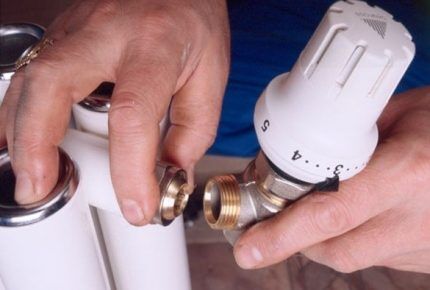
Device installation sequence
Installation should begin with cutting the pipes, which is done by stepping back a little from the radiator. The next step is to dismantle the existing shut-off valves. Next, separate the shanks from the valves and screw them into the radiator plugs.
Mount the harness in place, having previously assembled it, connect the pipes. All that remains is to adjust the temperature by turning the thermostat knob until the notches coincide with the existing marks on the body corresponding to a certain temperature.
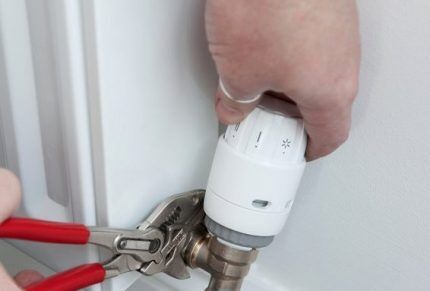
It is important that the arrow on the housing points towards the flow of hot coolant in the system. Otherwise, the work has been done in vain, nothing will work. The thermal head can be installed both at the inlet and outlet.
Manufacturers' recommendations regarding the installation level of the device should not be neglected, since it is calibrated for temperature conditions at this height. Basically it is 0.4 - 0.6 m from the floor.
But not all batteries have a top feed; it can also be a bottom feed. If there is no sample suitable in height, the solution is to set the thermal head to a lower temperature.
Since it is cooler near the floor, and the device is set to the temperature that should be at the top edge of the radiator, the room will be hot. To avoid this, you can install a thermal head with a remote sensor. There is also an option to configure the regulator yourself.
Features of setting up
For normal operation of the device, preliminary configuration is required. Before this, turn on the heating and isolate the room by closing the door.
At a certain point, install a thermometer and begin setting up:
- Turn the thermal head to the left until it stops so that the coolant flow is completely open.
- Wait until the temperature rises by 5-6° compared to the original.
- Turn the head all the way to the right.
- When the temperature drops to the desired value, the valve is gradually unscrewed. They stop rotation when noise appears in the radiator and the body becomes warm.
The last position of the thermal head corresponds to a comfortable temperature. It will be constantly supported.

The described sequence is suitable for most devices. If it is different, then it is not difficult to complete, since everything is described in detail in the passport.
What are the criteria for choosing a thermal head?
Thermostatic devices are produced by many manufacturers.
To make the right choice, you need to be guided by the following criteria:
- Thermal valve to which the head will be attached. Since the connection can be clip or threaded, you need to pay attention to this point. If the manufacturer is the same, there will be no problems.
- View of the threaded connection on the head itself. It can be in the form of a nut with curtains or simply round. In the first case, during installation you need an additional tool to crimp the connection. In the second, everything is much simpler.
- The presence of a “skirt”. The head looks better with it, because... it covers the work area.
- Material of manufacture. The cheapest are thermal heads in a plastic case. Expensive models have a metal body.
- Plastic quality. Some manufacturers, in order to reduce the cost of their products, use the cheapest type of plastic. The strength of the structure suffers from this, and over time the plastic turns yellow and loses its aesthetic appearance.
- Work Item Type. The choice will have to be made between liquid, gas, electronic and paraffin.
- Smooth rotation. The handle should rotate smoothly. This is a sign of good quality. Any cracking, squeaking or jamming indicates a not entirely high-quality product.
- Graduation and scale length. For most models it is in the range of +5 - +30 °C. If the graduation scale is located around the entire perimeter of the head, it can quickly wear out.
- Availability of anti-vandal casing. It protects against unauthorized access to settings.
- Design. Since thermal heads are mainly located in plain sight, their appearance and color scheme are important.
It is not necessary to purchase a ready-made kit consisting of a thermal valve and a thermal head. These devices can be purchased separately.
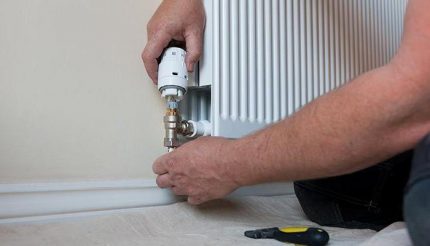
A thermal head equipped with automation benefits a lot, but it is not always effective. There is no point in mounting it on cast iron radiators. This material is very heat-intensive, and since the mass of the battery is large, it has great inertia. Only a manual type of head can work correctly here.
Brief overview of popular brands
The right decision when purchasing a thermal head would be to focus on reputable manufacturers. An unfamiliar trademark with an unknown history is a big risk of wasting money.
You can safely purchase products from manufacturers such as Dunfoss, Oventrop, Caleffi, Salus and other well-known companies.
Place #1 - Danfoss
The Danfoss concern has been producing thermal heads for over 60 years. This is a Danish manufacturer; under its license, products are also produced in Russia.
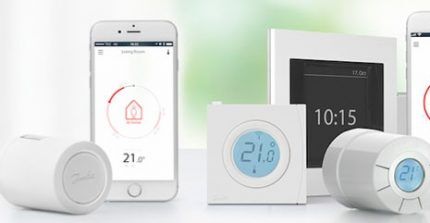
The most frequently asked question is the RTS Everis thermal head. This is a bellows product filled with liquid. By direct fixation it interfaces with proprietary thermal valves. Others require an adapter.
Test of existing types of brand thermal heads in the following video:
Place #2 - Oventrop brand
Oventrop thermal heads from the Uni line are in great demand among consumers. They are equipped with a liquid bellows. They are connected to the thermal valve using a union nut. The temperature can be set between +7 - +28 °C.
There is a possibility of complete closure. The heads are designed for a maximum temperature in the system of +100 - +120 °C - these are the characteristics indicated by the manufacturer in the accompanying documentation.
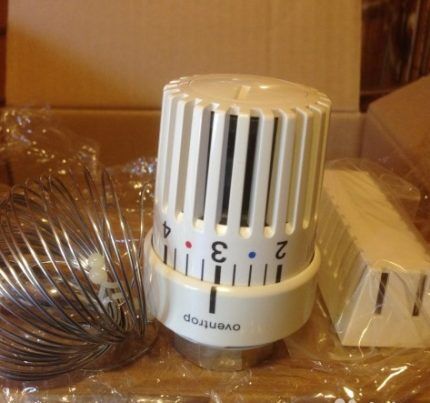
They are installed on thermostatic valves with a suitable connection. On the heads of many series there is a special mark for people with low vision and a vandal-proof casing.
Place #3 - Thermo company
Consumers highly appreciated the products of the Swiss company Thermo, in particular the Royal Thermo RTE 50.30 model.It has a wide adjustment range - from +6 to +28 °C, and a low hysteresis value - 0.55 degrees. There is also a zero position.
For correct operation, the coolant must have a temperature no higher than 100 °C. The connection to the valve is a union nut.
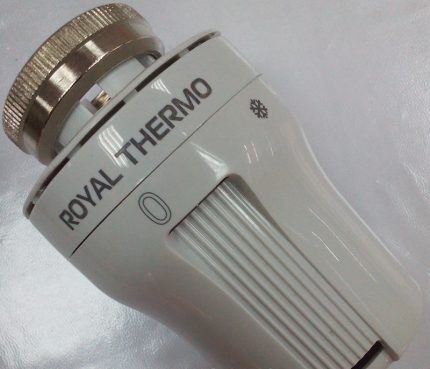
Place #4 - manufacturer Caleffi
The Italian manufacturer Caleffi supplies a wide range of radiator thermal heads. The Caleffi 210000 model is programmable. It is equipped with a digital LCD temperature indicator. In addition to the temperature value, it shows the time, date, and the set daily program.
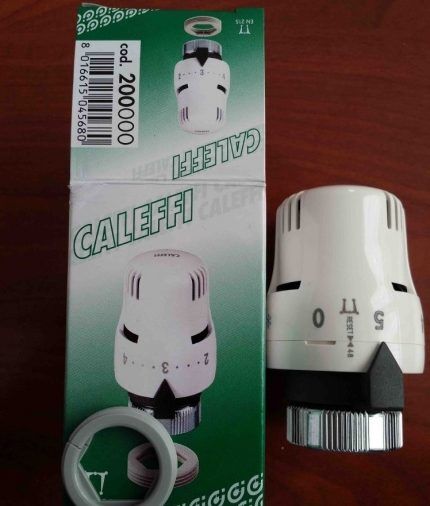
When programming for a week, you can set 3 temperature levels: “Comfort”, “Economy”, “Anti-freeze”. This head is installed in tandem with Keleffi valves.
Place #5 - Salus company
The German company Salus also enjoys a well-deserved reputation. For example, the Salus PH 60 model is an electronic head with non-volatile memory and the ability to set the temperature for a week. Temperature range - +5 - +40 °C.
Power is supplied from 2 AA elements. The display has the function of backlighting and displaying temperature parameters, as well as the charge level of the elements.

Technical innovations never cease to delight users - wireless thermal heads allow the owner to create a comfortable indoor microclimate, while being at the other end of the city or another country. And all this becomes possible if you integrate the device into the system smart home heating or download a proprietary application.
Conclusions and useful video on the topic
The design and purpose of the thermal head is discussed in detail in the following video:
Is it worth installing a thermal head on batteries? One of the users talks about this in detail in his video review:
Thermostatic valve and head in action:
A heating circuit with a thermal head is more convenient to use. This device increases the service life of the equipment included in the heating system and increases its fire safety level.
Based on the benefits of these relatively simple devices and their 20-year service life, they are inexpensive. To buy a truly high-quality product, find out if there is a certificate for the selected device.
Do you use thermal heads for your heating equipment? If yes, then share your personal experience of installation and operation, add photos, tell us whether you are satisfied with these devices and how much more comfortable the microclimate in your home has become after installing thermal heads.
If you still have questions, do not hesitate to ask them in the comments block - our experts and competent users will try to cover complex issues as clearly as possible.
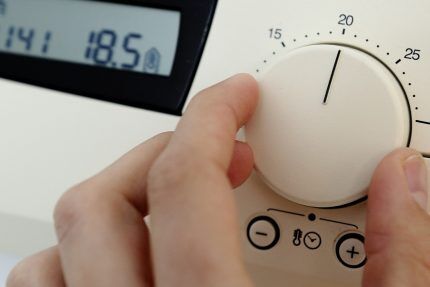




I want to install a thermal head for a heating radiator. The thing seems to be useful, but I had a lot of questions about it.For example, how accurately is the temperature in the room regulated, with what error? And does it depend on external factors? That is, is it necessary to regulate it if, for example, there is severe frost outside, or once you set the desired temperature and it keeps it regardless of the outside temperature?
By and large, “set it and forget it.” Sometimes, of course, you will have to tighten it based on subjective feelings of comfort. There is an error, it depends on many factors, but in general the temperature stays approximately the same as you set it. I have thermal heads with valves from Valtec, I am very pleased. The temperature remains stable and does not fluctuate.
The problem here is that the adjustment occurs in a very narrow range. From number 3 to number 4. The rest is either completely closed (0 - 3 battery is cold) or completely open (4 - 5 battery is boiling water). It also depends how tightly you screw the head to the valve. In short, a dance with a tambourine. And on each battery everything is individual.
Hello! Tell me, is it possible to replace the thermostatic solid-state head (6.5-27.5°C) VT.1000.0.0 with a Chinese thermal head with a remote TIM Industries sensor? The threads seem to be the same. And how to do this? Is it possible to twist them yourself? Is it necessary to drain the riser?
How will the boiler work? constantly fry? so that the head can adjust the selected temperature... where is the savings?
Royal Thermo is not a Swiss brand, but an Italian, or rather Russian-Italian. The Rusklimat trading company promotes this brand in our market. They do not produce thermal heads, but order from Danfoss. From RT only the inscription.The rating is incorrect, this brand cannot participate in it because... is not a manufacturer. But these brands could be indicated: Heimeier, Herz, Rossweiner, Simplex-Flamco